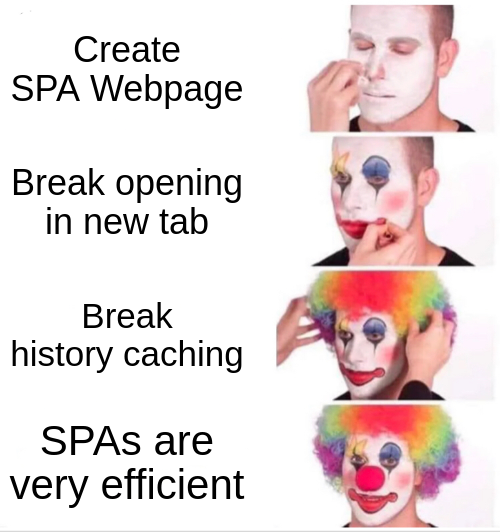this post was submitted on 03 Feb 2024
473 points (94.2% liked)
Programmer Humor
32710 readers
128 users here now
Post funny things about programming here! (Or just rant about your favourite programming language.)
Rules:
- Posts must be relevant to programming, programmers, or computer science.
- No NSFW content.
- Jokes must be in good taste. No hate speech, bigotry, etc.
founded 5 years ago
MODERATORS
you are viewing a single comment's thread
view the rest of the comments
view the rest of the comments

What some folks are missing is that SPAs are great for web applications & unsuitable for web pages. There is more nuance than “SPA bad”.
Then dealing with a lot of dynamic content, piping thru a virtual DOM DSL is 100× nicer for a developer than having to manually manipulate the DOM or hand write XML where it’s easy to forget all the closing tags (XML is better as a interchange format IMO & amazing when you need extensibility… also JSX just makes it worse). That developer experience (DX) often can lead to faster iteration & less bugs even with a cost to the user experience (UX). But it’s not always a negative impact to the UX--SPAs can be used to keep things like a video or music player on while still browser & using the URL bar as a state reference to easy send links to others or remember your own state.
It’s equally silly that a landing page whose primary purpose is to inform users of content takes 40s to load & shows “This applications requires JavaScript” to the TUI browser users & web crawlers/search indexers that don’t have the scale of Google to be executing JavaScript in headless browser just to see what a site has to say.
The trick is knowing how & when to draw these lines as there’s even a spectrum within the two extremes for progressive enhancement. React isn’t the solution to everything. Neither is static sites. Nor HTMX. Nor LiveView. Nor Next/Nuxt/Náxt/Nüxt/Nœxt/Nอxt.
I don't agree with this hard split between SPAs and MPAs anymore (ie. SPAs for apps, MPAs for websites/content). In my opinion SPAs are simply a progressive enhancement for MPAs which allow even faster page navigation. All frameworks now come with SSR solutions and if a website still requires JS to show content that's a skill issue.
Looking at Astro the line between SPA/MPA is getting really blurry. Just slap a View Transition element on your page and you got a MPA which acts like a SPA when JS is enabled.
While I agree that there is a spectrum (hinting at that with the last paragraph), this is where I hard disagree. To construct something like this, you are making an application massively complex by trying to re-implement everything on both ends. Using something like Astro is only hiding that complexity but it’s still there, & probably full of bugs & tons of JavaScript that most developers wouldn’t even understand their stack or know how to jump into the Astro code. The amount of time saved is largely minuscule in most cases with the assets cached when navigating to a new page. In fact, I just tested two of their showcased sites which loaded slower with JavaScript enabled & the content was pretty obviously 95% static. There’s probably some niche use cases for this, but it’s not a good default IMO.
What is a web page vs web application? The web is so complex with features these days that pretty much everything is an application.
Gmail is a (bad) web application. A marketing website or even an ecommerce store are not.
I admitted it was a spectrum, but this recent article in particular does a good job explaining the axes of static vs. dynamic : online vs. offline. I think you will appreciate it. :)